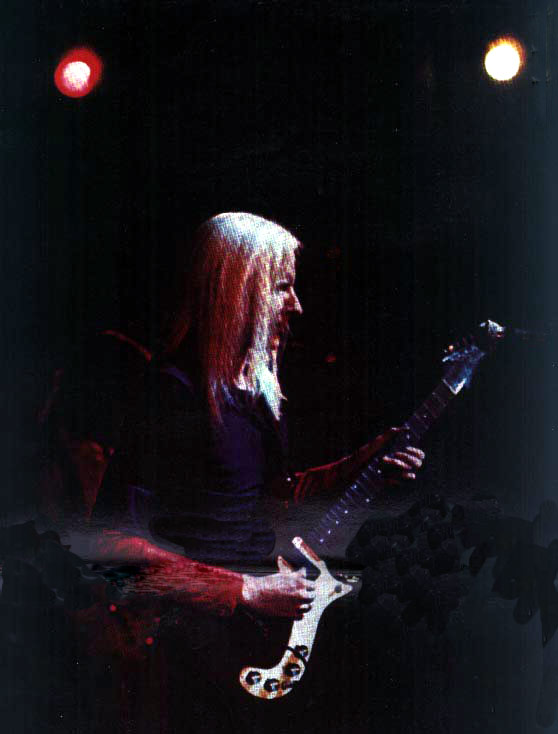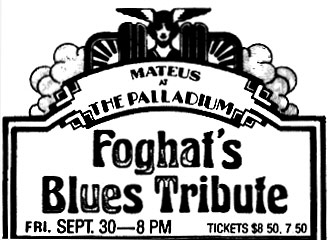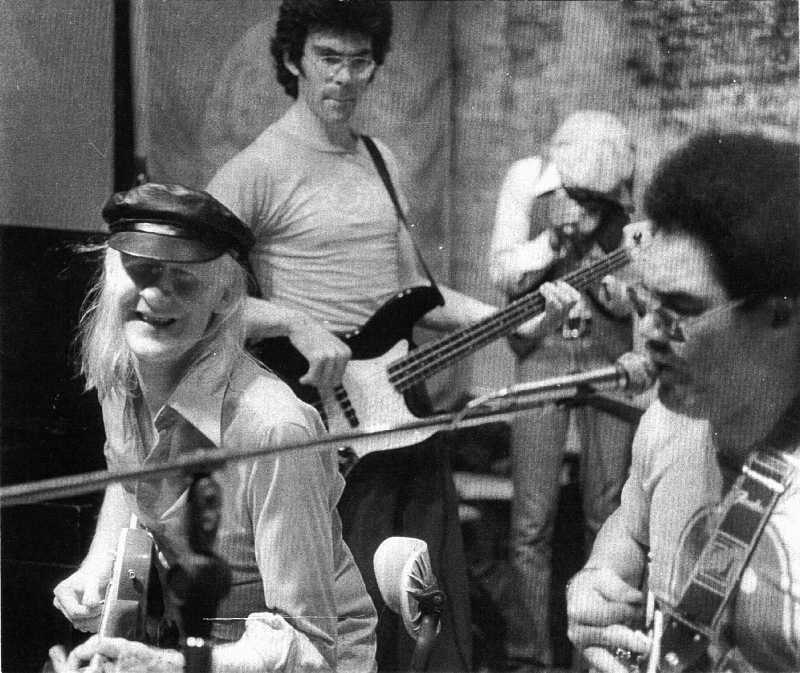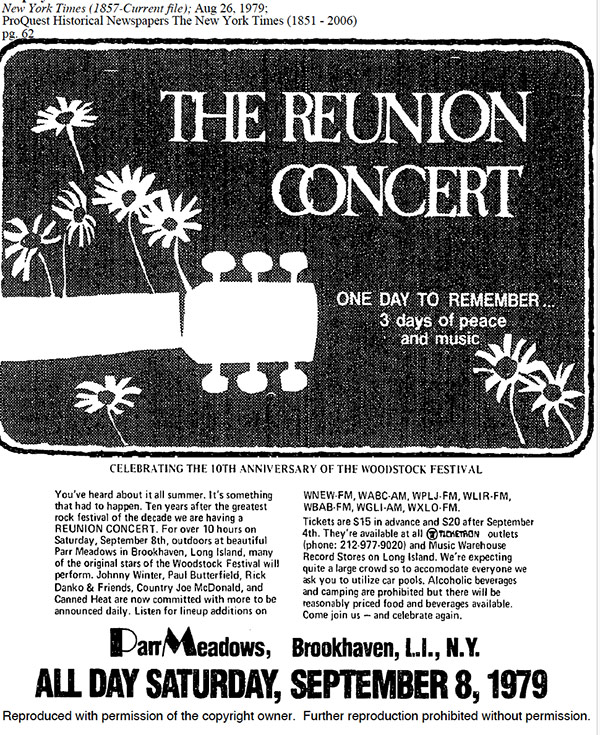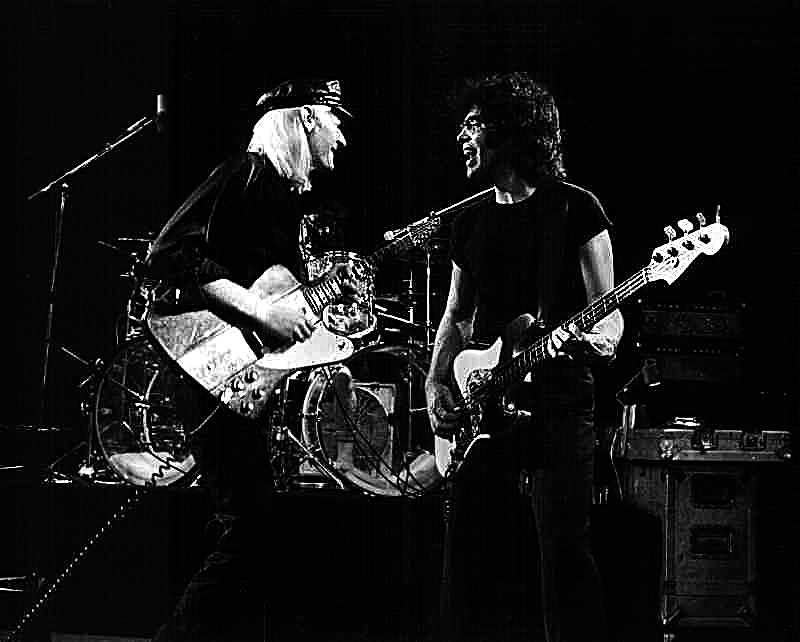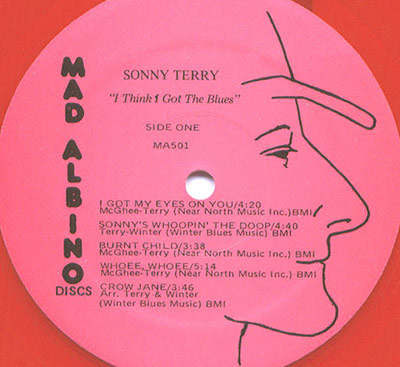Hellwig's funny yodeling - you might as well play in major and minor with Heck's playback, or invite yourself to do something musical with silly gags and create excuses that still work, but for how long?
But enough of that, let's go back to the current Rockpalast night - the topic of the raped Germans in the media will find its place at a later date - and let's rather deal again with the event: J. Geils Band, Patti Smith Group, and Johnny Winter Band.
The things on the edge
Already on Monday of the week, the first working groups of the WDR arrived in Essen and began with the preparations. The Tasco crew also arrived soon, and little by little, curious observers, photographers, journalists, and merchandisers arrived to experience the soundcheck of the Johnny Winter Band on Wednesday, observe Patti Smith on Thursday, and then the J. Geils Band on Friday.
While Johnny Winter left after his soundcheck to fulfill a concert obligation in Hamburg, Patti Smith had announced a full cultural program. Interviews and artistic proofs were delivered by them en masse before and after their soundcheck. The J. Geils Band, on the other hand, preferred to be a normal rock 'n' roll band on tour. Funny, open-minded, always ready for jokes and chats, they still provided the most relaxed atmosphere.
Sometime during all their work, Patti Smith, this time without a manager, still had enough time to make an attempt to make some money on the side. It was about the sale of "badges." In her opinion, 7 - 8,000 people would come to the Grugahalle just because of Patti Smith, and thus it would be a breeze to sell about 2,000 Patti Smith badges. However, she did not have the badges with her, but they were made by Fundgrube Rheinhausen.
Now the clever lady said to the Fundgrube owner Führsen, she wanted to collect 1 "deutsch Mark" for each badge sold, and since at least 2,000 would be sold, she wanted to collect the 2,000 "deutsch Marks" directly in cash per advance payment. Illusion on the one hand, commercial thinking on the other. Finally, the merchant won, no superstar conditions and no business, and so there were no Patti Smith badges to buy.
The J. Geils had other things to do. With professionalism born of experience and skill, they consistently took care of the stage sound and the setup of their equipment. I've been hanging around concerts and soundchecks for over 15 years and have seen some amazing things, but the professionalism of this band, this stage setup surprised me. Everything is designed so that it can be set up with the least amount of time and effort, with the entire system consisting of modified units that were built with transport in mind.
But more on that elsewhere, just as we still have a lot to write about harmonica player Magic Dick, because of what he told us about his colleagues, about the J. Geils...
Talking about Johnny Winter's sound and his harmonica playing would go beyond the scope here. The night itself brought the unexpected and created an order of dominance. Stainless Steel - flawless heavy rock from the J. Geils Band. The hall was roaring. Although initially difficult to get going, too many visitors probably hadn't heard enough from this band yet, the spark jumped over and set the fans on fire. Despite the emotional boundaries drawn by the ever-present cameras of the television crew, the kids forced four encores.
Consequently, it was only understandable that Patti Smith didn't manage to pull the audience onto her track with the first few bars. Perhaps it's also because the J. Geils Band, musically and technically, knows exactly what they're doing, what they can do, and can also demonstrate their skills, while with the Patti Smith Group too much unspoken is involved. After J. Geils' guitar, Lenny's out-of-tune guitar was no longer relevant, and Patti's solos are perhaps a demonstration of a subcultural commitment, but not a musical demonstration of a guitar player. Nevertheless, she managed to captivate a whole row of listeners, and in a program geared towards her craft, she could still have been the winner of the evening. But here and today, musical ability counted, the clear language of musicians who mastered their vocabulary counted, the emotional and yet crystal-clear argumentation of rock music counted.
This became particularly clear when Patti tried to make it clear to her fans that it was about "My Generation" here and now. But wild sounds alone don't make a new generation, such sounds may have their meaning, may be the ultimate for fans of the 'riot and destruction rock' direction, but they don't count for "My Generation". Johnny Winter had this language that evening. With a barely comprehensible feeling for expression and modulation, he told the assembled rock disciples in the hall and in front of the screens what this music has to say.
The depth of feeling, born out of outcry, protest, and aggressive despair, that Johnny let flow into his guitar playing that morning set new standards. Sure, there was a time when Johnny played even faster, even more actively pushing forward, but I don't think he ever played so well. While other guitarists become technically more brilliant through increasing practice and experience, become even faster, Johnny has become more mature, more humane. Johnny is no longer just the miracle guitarist with the fast fingers, it's more, it's similar to Jimi Hendrix with his guitar becoming the medium of communication.
A guitarist from the Rhenish metropolis who followed Johnny's marathon on the screen got his "moral" and said "it's not that he plays better than me, it's just that his guitar talks, whatever he wants, without compromises." And so this night was necessary, because even more than bringing the Rockpalast team the long-deserved super success, it also made it clear where the premises are set in rock. It's the musician who has something to say, who is still in the front row, who is accepted by the people. And that alone is why it's necessary to have a Rockpalast, because in the direct confrontation with the audience - live in front of the screen and live in the hall, in the equally direct confrontation of the groups and artists, the wheat is separated from the chaff.
That alone was why it was good to have this evening, because with this program, Rockpalast also provided clarification of the current rock situation, gave the rock disciples the opportunity to compare harshly and directly, to weigh things up, and thus created the basis for taking a newly thought-out standpoint. Whatever criticism will be voiced, whatever is said about the J. Geils Band, Patti Smith, and Johnny Winter, it can only come from this comparison. Heavy Metal. Demonstrator rock or electric blues - what will be weighed and found too light. The further development and the events that arise from this night, or arose at this time, will show how important this night was, whose programs were given to us by Peter Rüchel and Christian Wagner.
But what else belongs to such a night is all too easily overlooked, not recognized, although the substructure also... Let's leave aside the areas of creative work before and during the broadcast, and let's just deal with the things that are necessary for this creativity to unfold, i.e. the substructure of the production. Where and when does the work, the problems start.
Well, first of all, we need to have a hall that gives us the opportunity to start work five or six days before the broadcast date. Apart from the fact that we already knew the Grugahalle from some other occasions and we were able to work well there, we still had to clarify whether it would be available these five to six days beforehand. With the approximately two hundred and fifty events that the hall hosts a year, certainly not an easy request from us to fulfill, but I can say that hall boss Tallarek is extremely committed to it and has always created the opportunity to occupy the hall so early. Once this foundation was in place, we only started with the actual preparation.
We considered what we needed, four camera vans, we need to record the interviews backstage, so another two cameras, Christian also wants a camera on stage, so that would be seven cameras, plus the cameras for the announcement in front of the hall. Next come the concerns of the radio to ensure the stereophonic transmission. So we need a transmission van with at least thirty channels stereo. An OB van on site and two stationary OB vans here in Cologne also had to be secured, as well as the large screen system for the hall interior. I had suggested to Peter Rüchel - as almost always - to also present the audience in the hall with video material from behind the stage in addition to the sound, and Peter was enthusiastic about this idea. But WDR doesn't have such a system, it had to be borrowed from Südwestfunk.
But these are all areas that can be clarified and procured here at WDR. The stage lighting and the PA system present us with completely different tasks. We don't have such a lighting system because we can't use it for normal television production, and WDR doesn't have a sound system to sound such large spaces for the same reason. So we had to make phone calls and get offers. In the first year, we tried it with Flash Light & Sound, but almost fell flat on our faces, and therefore hired Tasco for the second production. But Tasco chooses its customers, they don't take just anyone, and who is WDR anyway. Well, we finally convinced them to take a chance with us.
With what effort does Tasco travel to Essen? Tasco comes with 12 staff and two 20-ton trucks of equipment, with the lighting equipment taking up the most space. In addition, there are the CSI spots, which are also brought along by Tasco and have such power that they still throw 1000 lux of light onto the stage after sixty meters. You could already get an idea of the two PA towers with 6000 watts each from the television pictures. The PA was controlled with a 36-channel mixer. These are just the big things, all the little things like stage boxes and cables and mics and whatever else is needed can't even be listed here. In addition, there are the systems for the stage mix and the entire lighting control. The whole sound system is set up by the Tasco guys in less than six hours.
Now you might think that the main work for the guys is done after setting up the system, but far from it. Even if every band brings their own crew and sends their own sound engineer to the mixer, the Tasco people are still fully involved. Almost every day they have to be on the ball for 18 hours because something always happens, a band has this or that idea, or new demands on the equipment arise from our television needs. But there haven't been any real problems so far, as usual, it's only the little things that cause the ongoing tension. On the other hand, Tasco is also able to provide full replacement for any device within a very short time.
It's Harder to Make the Big Small
It is considerably more difficult to draw the big ones small than to draw the small ones big - this or something similar could be the first realization of the 4th Rockpalast Festival. If the whole event had not been too big and overwhelming to be dealt with in one sentence, this observation might have captured its essence. By far, this festival was the most successful, measured by both television ratings and the sheer number of people who attended in person at the Gruga Hall in Essen.
A Sold-Out Spectacle
The hall was completely sold out, and press releases across the country were filled with stories of communities gathering around their televisions to experience the rock night live in picture and stereo sound. The list of connected participants was impressive. Directly involved were the stations from Austria, Norway, Sweden, Switzerland, Yugoslavia, and Bulgaria. The French also recorded the event, but only broadcast the Patti Smith part live.
Radio Waves Across Borders
Also connected were numerous radio stations, including NDR 3, Radio Bremen 2, Saarländischer Rundfunk 2, Sender Freies Berlin UKW 92.4 MHz Kanal 18, Süddeutscher Rundfunk 3, and Bayern 3. The Hessians were notably absent for unknown reasons, but the reach extended beyond Germany, with stations like Studio Lausanne and Studio Zurich in Switzerland ensuring stereophonic pleasure for their listeners. Estimates suggested that between thirty and forty million rock fans were glued to their TV screens and radios that night, a success likely unmatched in Europe.
A Program's Triumph
A program had triumphed, defying naysayers and those who once dismissed it as "only regional." It had become arguably the most important factor in the European rock scene. Of course, this applied specifically to the Rockpalast festival series and not to the regular Rockpalast programs, which still had limited reach. The discrepancy between audience desires and public broadcasting decisions remained, a result of paternalistic choices that disadvantaged a significant portion of the population without lobbyists.
The Future of Rock on the Airwaves
But change was inevitable. The "keepers of the Holy Grail" in public broadcasting would eventually have to yield. Technological advancements like satellite TV and cable television, potentially free from political influence, would force them to acknowledge the "unculture of rock." The new generation of decision-makers couldn't afford to ignore the essential needs of young people, as their predecessors had done. While politicians and television executives might favor other forms of entertainment, they couldn't deny the power and popularity of rock music forever.
Back to the Rockpalast Night
But enough of that for now. Let's return to the Rockpalast night in question. The topic of how the media portrays Germans will be addressed later. For now, let's focus on the main event: the performances by the J. Geils Band, the Patti Smith Group, and the Johnny Winter Band.
The Things on the Edge
As early as Monday of that week, the first WDR workgroups arrived in Essen and began preparations. The Tasco crew also arrived soon after, and curious observers, photographers, journalists, and merchandisers gradually trickled in to witness the Johnny Winter Band's soundcheck on Wednesday, observe Patti Smith on Thursday, and then the J. Geils Band on Friday.
While Johnny Winter left after his soundcheck to fulfill a concert obligation in Hamburg, Patti Smith had a full cultural program planned. She delivered interviews and artistic demonstrations en masse before and after her soundcheck. The J. Geils Band, on the other hand, preferred to be a normal rock 'n' roll band on tour. Funny, open-minded, always ready for jokes and chats, they were the ones who most likely created an atmosphere of ease.
At some point during all their work, Patti Smith, this time without her manager, still had enough time to try to make some extra money on the side. It was about selling "badges." In her opinion, 7-8,000 people would come to the Grugahalle just because of Patti Smith, and thus it would be easy to sell about 2,000 Patti Smith badges. However, she didn't have the badges with her; they were made by Fundgrube Rheinhausen.
Now, the clever lady told the Fundgrube owner, Führsen, that she wanted to collect 1 Deutschmark for each badge sold, and since at least 2,000 would be sold, as mentioned, she wanted to collect the 2,000 Deutschmarks directly in cash in advance. Illusion on one side, business thinking on the other. In the end, the businessman won, no superstar conditions and no business, and so there were no Patti Smith badges to buy.
The J. Geils Band, on the other hand, had other things to do. With professionalism born from experience and skill, they consistently focused on the stage sound and the setup of their equipment. I've been hanging around concerts and soundchecks for over 15 years and have seen some amazing things, but the professionalism of this band, this stage setup, surprised me. Everything is designed so that it can be set up with the least amount of time and effort, with the entire system consisting of modified units created with transportation in mind. But more on that elsewhere, just as we still have a lot to write about harmonica player Magic Dick, because what he told us about his colleagues, about the J. Geils sound, and about his harmonica playing would go beyond the scope here.
The night itself then brought the unexpected and ensured an order of dominance. Stainless Steel - flawless heavy rock from the J. Geils Band. The hall roared. Although initially difficult to get going, too many visitors probably hadn't heard enough from this band yet, the spark jumped over and set the fans on fire. Despite the emotional boundaries drawn by the ever-present cameras of the television crew, the kids forced four encores.
Consequently, it was only understandable that Patti Smith didn't manage to pull the audience onto her track right from the first notes. But perhaps it's also because the J. Geils Band, musically and technically speaking, knows exactly what they're doing, what they can do, and can also demonstrate their skills, while with the Patti Smith Group, too much remains unspoken.
After J. Geils' guitar, Lenny's out-of-tune guitar was no longer relevant, and Patti's solos may be a demonstration of subcultural commitment, but not a musical demonstration of a guitar player. Nevertheless, she managed to captivate a whole row of listeners, and in a program geared towards her craft, she could have been the winner of the evening. But here and today, musical skill counted, the clear language of musicians who mastered their vocabulary counted, the emotional yet crystal-clear argumentation of rock music counted. This became particularly clear when Patti tried to make it clear to her fans that it was about "My Generation" here and now. But wild sounds alone don't make a new generation, such sounds may have their significance, may be the ultimate for fans of the 'rebellion and destruction rock' genre, but they don't count for "My Generation."
Johnny Winter had this language that evening. With a barely comprehensible sense of expression and modulation, he told the assembled rock disciples in the hall and in front of the screens what this music has to say. The emotional depth, born from outcry, protest, and aggressive despair, that Johnny infused into his guitar playing that morning set new standards. Sure, there was a time when Johnny played even faster, even more actively pushing forward, but I don't think he ever played so well.
While other guitarists become technically more brilliant, even faster, through increasing practice and experience, Johnny has become more mature, more humane. Johnny is no longer just the miracle guitarist with the fast fingers, it's more, it's similar to Jimi Hendrix, his guitar has become a medium of communication. A guitarist from the Rhenish metropolis who followed Johnny's marathon on the screen got his "moral" and said, "It's not that he plays better than me, it's simply that his guitar speaks what he wants, without compromises."
And so this night was necessary because, even more than bringing the Rockpalast team the long-deserved super success, it also made it clear where the premises are set in rock. It's the musician who has something to say who still stands in the first row, who is accepted by the people. And that alone is why it's necessary to have a Rockpalast because in the direct confrontation with the audience - live in front of the screen and live in the hall, in the equally direct confrontation of the groups and artists - the wheat is separated from the chaff.
That alone made it good to have this evening because with this program, Rockpalast also ensured a clarification of the current rock situation, gave the rock disciples the opportunity to compare harshly and directly, to weigh things up, and thus created the basis for taking a newly thought-out standpoint. Whatever criticism may be voiced, whatever may be said about the J. Geils Band, Patti Smith, and Johnny Winter, it can only come from this comparison. Heavy Metal. Demonstrator Rock or Electric Blues - what will be weighed and found too light.
Further development and the events that arise from this night, or arose at this time, will show how important this night was, whose programs were brought to us by Peter Rüchel and Christian Wagner.
But what else belongs to such a night is all too easily overlooked, not recognized, even though the substructure here - as almost always - makes the events and actions possible in the first place. We therefore spoke with Wilhelm Lang and Barbara Lücke, who were responsible for this event from the technical side, from the production side.
Merlin W. Frank
